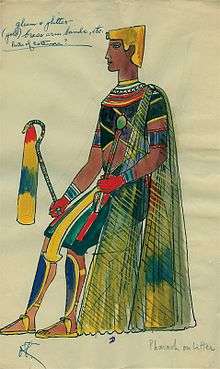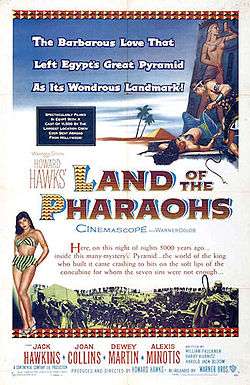Land of the Pharaohs
| Land of the Pharaohs | |
|---|---|
|
1955 theatrical poster | |
| Directed by | Howard Hawks |
| Produced by | Howard Hawks |
| Written by |
Harold Jack Bloom William Faulkner Harry Kurnitz |
| Starring |
Jack Hawkins Joan Collins James Robertson Justice |
| Music by | Dimitri Tiomkin |
| Cinematography |
Lee Garmes Russell Harlan |
| Edited by | Vladimir Sagovsky |
Production company |
Continental Company |
| Distributed by | Warner Bros. Pictures |
Release dates |
|
Running time | 106m (US), 104m (UK) |
| Country | United States |
| Language | English |
| Budget | $2.9 million (estimated) |
| Box office | $2.7 million (US)[2] |
Land of the Pharaohs is a 1955 American epic film in Cinemascope, directed and produced by Howard Hawks and starring Jack Hawkins and Joan Collins as Pharaoh Khufu (also known as Cheops) and his second wife Nellifer, in fictional account of the building of the Great Pyramid. Novelist William Faulkner was one of the three screenwriters.
The film literally had a cast of thousands (Warner Bros. press office claimed there were 9,787 extras in one scene)[3] and was one of Hollywood's largest-scale, ancient world epics, in the spirit of The Robe, The Ten Commandments, Ben Hur, and others. The film was shot on location in Egypt and in Rome's Titanus studios.
Plot
In ancient Egypt, Pharaoh Khufu (Jack Hawkins) is obsessed with preparing his tomb for the "second life". Dissatisfied with his own architects' offerings, he enlists Vashtar (James Robertson Justice), an ingenious man whose devices nearly saved his own people from being conquered and enslaved by Khufu. Khufu offers to free Vashtar's people if he will build Khufu a robber-proof tomb - although Vashtar will have to die when the pyramid-tomb is completed, to guard its secrets. During the years that the pyramid is being built, Pharaoh demands tribute and labor from all his territories, amassing gold and treasures to be interred with him.
Princess Nellifer (Joan Collins) comes as the ambassador of the tributary province of Cyprus. Claiming her province is poor and cannot afford to pay the assigned tribute, she offers herself to Pharaoh instead. She becomes Khufu's second wife.
Nellifer questions whether Khufu really had as much gold as he says, so she is shown an enormous hoard of fine gold artifacts and jewels, and more in an inner vault that Khufu is saving for his "second life." She puts on an ornate, jewel encrusted necklace which Khufu angrily demands she remove. When she doesn't, he orders Treneh (Sydney Chaplin), the captain of the guard, to take it off her and leaves. Later, Nellifer starts an affair with Treneh. who has become besotted with her.
One day on the construction site Vashtar's son, Senta (Dewey Martin), saves Khufu from being crushed to death by a runaway stone block. In order to get the injured Khufu out of the pyramid to help, Senta reveals that he too knows the tomb's secrets, knowing that he must now share his father's fate. A grateful Pharaoh offers him anything else within his power; Senta chooses Nellifer's slave Kyra to save her from being whipped for her fierce independence.
Using a cobra obtained from a snake charmer with the help of Treneh, Nellifer plots to assassinate first Queen Nailla and her son Zanin, then Khufu, leaving her to rule Egypt. First, Treneh persuades Khufu that there is a rich hoard of treasure in a tomb far to the north, in order to draw him away from the palace. Then Nellifer gives Zanin a flute to practice and teaches him a tune the snake will be attracted to. Queen Nailla sees the snake approaching Zanin and throws herself on it to save her son.
Hearing of the queen's death, Khufu sends out investigators to look for snake charmers. Panicking, Nellifer dispatches her servant Mabuna to kill Khufu at the oasis, but Mabuna only manages to wound Khufu before being killed. Suspecting Nellifer, Khufu rushes back to the city. In her chambers he overhears her and Treneh plotting; he kills Treneh in a sword fight, but is himself fatally wounded. The Pharaoh, before dying, see Nellifer wearing the necklace that he deliberately took from her earlier, and then dies while calling out for his High Priest and lifelong friend Hamar (Alexis Minotis, billed as Alex Minotis).
After Khufu's death, Hamar, suspecting what Nellifer did and deeming the tomb truly robber-proof, even for Vashtar and Senta, releases them from their death sentences, allowing them to leave Egypt and return to their homeland with their people as part of a plan to deal with Nellifer.
During Pharaoh's funeral, Hamar has Nellifer accompany him into the burial chamber because she "must give the order" to seal the sarcophagus. When her order is obeyed, it releases a large stone in a lower chamber, triggering Vashtar's mechanism to seal the tomb. Nellifer goes into hysterics when told the tomb is being sealed, realizing she is trapped. "There's no way out," Hamar tells her, adding: "This is what you lied and schemed and murdered to achieve. This is your kingdom."
Cast

- Jack Hawkins as Pharaoh Khufu
- Joan Collins as Princess Nellifer
- Dewey Martin as Senta
- Alex Minotis as Hamar
- James Robertson Justice as Vashtar
- Luisella Boni as Kyra (as Luisa Boni)
- Sydney Chaplin as Treneh
- James Hayter as Mikka
- Kerima as Nailla
- Piero Giagnoni as Xenon
Production notes
- The costume designs are the work of French painter and costume designer Mayo, already known for his work on Les Enfants du paradis or La Beauté du diable.[4]

- When the Pharaoh was inspecting, and rejecting, the Egyptian architects' models for his tomb, the third model he looks at is a model of the actual interior of the pyramid built for Khufu.
- The movie was Howard Hawks's first commercial failure. It caused Hawks to take a break from directing and travel through Europe for a number of years. He made his next movie, Rio Bravo (1959), four years later - the longest break between two movies in his career.
- For scenes showing the pyramid under construction, the film crew cleared the sand off a ninety-foot deep shaft part of the unfinished pyramid of Baka. Elsewhere they built a ramp and foundation the size of the original pyramid, where thousands of extras were filmed pulling huge stone blocks.
- Other scenes were shot at a limestone quarry at Tourah, near Cairo, and at Aswan, a granite quarry located 500 miles away. At these sites 9,787 actors were filmed in one scene.
- Hawks had between 3,000 and 10,000 extras working each day during the fifty-plus day shooting schedule. The government supplied the extras, half of whom were soldiers in the Egyptian Army
Reception
Lacking a strong cast, the film was unsuccessful at the box office, earning $450,000 short of the $3,150,000 spent on producing it. The picture gained more interest over the years and has been defended by Martin Scorsese, French critics supporting the auteur theory, and for numerous elements of its physical production. Danny Peary in his book Cult Movies (1981), selected it as a cult classic.[5] The film's reputation continues to improve with the test of time. As of 2013, Land of the Pharaohs currently holds 71% fresh approval rating on Rotten Tomatoes.
See also
References
- ↑ The Times, 2 May 1956, page 3: Review of Land of the Pharaohs, which states that the film opens "at the Warner Cinema to-morrow". Retrieved from The Times Digital Archive 2013-08-09
- ↑ 'The Top Box-Office Hits of 1955', Variety Weekly, January 25, 1956
- ↑ A. H. Weiler (July 27, 1955). "'Land of the Pharaohs' Is Standard Saga". New York Times. Retrieved 2007-12-19.
- ↑ Yeatman-Eiffel, Evelyne (2012). Mayo. France: mayo-peintre.com. pp. 143–150.
- ↑ Peary, Danny. Cult Movies, Delta Books, 1981. ISBN 0-517-20185-2
External links
- Land of the Pharaohs at the American Film Institute Catalog
- Land of the Pharaohs at the Internet Movie Database
- Land of the Pharaohs at AllMovie
